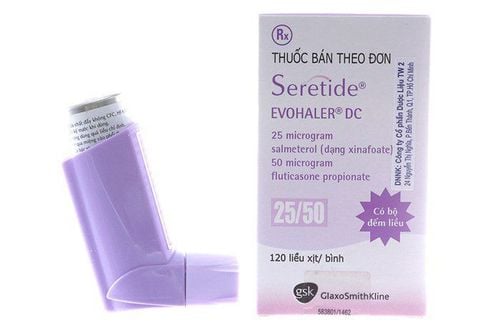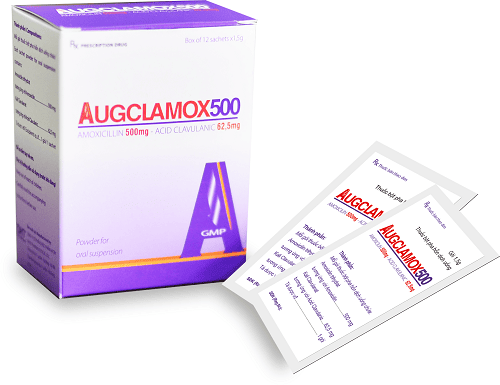This is an automatically translated article.
Tacerax is prepared in the form of powder for oral suspension, with the main ingredient being Cefuroxim. The drug is used in the treatment of certain diseases caused by bacterial infections.1. What are the effects of Tacerax?
Each pack of Tacerax 125mg contains Cefuroxim 125mg and excipients. Cefuroxime axetil, when entering the body, will be hydrolyzed by the enzyme Esterase, becoming an active antibiotic in the active form, Cefuroxim. Cefuroxime is a 3rd generation cephalosporin antibiotic, used in many infections. The mechanism of action of Cefuroxime is to bind to penicillin-binding proteins, inhibiting bacterial cell wall synthesis. Thereby, disrupting the biosynthesis of the cell wall, leading to lysis, killing bacterial cells.
Indications for use of Tacerax:
Treatment of acute otitis media; Treatment of acute tonsillitis and pharyngitis caused by streptococci; Treatment of acute bacterial sinusitis; Treatment of exacerbations in chronic bronchitis; Treatment of pyelonephritis or cystitis; Treatment of uncomplicated skin and soft tissue infections; Treatment of early Lyme disease. Indications for use of Tacerax:
Patients with hypersensitivity, allergy to Cefuroxim or other components of the drug; Hypersensitivity to cephalosporin antibiotics.
2. Instructions on how to take Tacerax
Usage: Orally. The drug should not be used for any other purpose. The way to prepare the suspension is: Pour the entire amount of powder in the package into a cup, mix with a sufficient amount of water. Before taking, the patient should shake the glass of water so that the medicine is evenly dispersed and then drink it immediately. For optimal absorption, the patient should take the drug with food.
Dosage:
Dosage for adults and children over 40kg:
Pharyngitis, tonsillitis, bacterial sinusitis: 250mg/time x 2 times/day; Acute otitis media: 500mg/time x 2 times/day; Exacerbation in chronic bronchitis: 500mg/time x 2 times/day; Uncomplicated skin and soft tissue infections, pyelonephritis or cystitis: 250mg/time x 2 times/day; Lyme disease in the early stages: Use 500mg / time x 2 times / day, treat for 10-21 days. Dosage for children under 40kg:
Pharyngitis, tonsillitis, sinusitis caused by bacteria: Use dose 10mg/kg/time x 2 times/day. The maximum dose is 125mg/time x 2 times/day; Children 2 years and older with otitis media: 15mg/kg/time x 2 times/day. The maximum dose is 250mg/time x 2 times/day; Cystitis, skin and soft tissue infections uncomplicated: Use dose 15mg/kg/time x 2 times/day. The maximum dose is 250mg/time x 2 times/day; Pyelonephritis: Use dose 15mg/kg/time x 2 times/day. The maximum dose is 250mg/time x 2 times/day. 1 course of treatment for 10-14 days; Lyme disease: Use dose 15mg/kg/time x 2 times/day. The maximum dose is 250mg/time x 2 times/day. Treatment for about 10 - 21 days.; Missed dose: If you forget to take a dose of Tacerax, you should take it as soon as you remember, as soon as possible. However, if it is almost time for your next dose, skip the missed dose and take your next dose as directed at the beginning.
Overdose: Using more than the recommended amount of Tacerax can lead to neurological sequelae such as encephalopathy, coma or convulsions, nausea, vomiting and diarrhea. Overdose symptoms may also occur if the dose is not appropriately reduced in patients with renal impairment. Regarding management, attention should be paid to the possibility of overdosage, protection of the patient's airways, ventilation support, and intravenous fluids. If the patient has a seizure, the drug should be stopped immediately, and anticonvulsant therapy may be used if indicated. Treatment is primarily supportive or symptomatic, although hemodialysis can help remove drugs from the blood.
3. Tacerax side effects
During the use of Tacerax, patients may experience some side effects such as:
Common: Headache, dizziness, digestive disorders, Candida overgrowth, transient increase in liver enzymes, increased eosinophils; Uncommon: Vomiting, dermatitis, leukopenia or thrombocytopenia; Rare: Jaundice, fever, urticaria, pseudomembranous colitis, erythema, skin itching,... If you experience any unusual symptoms, the patient should immediately notify the doctor for advice. appropriate instructions.
4. Notes when taking Tacerax
Before starting treatment with Tacerax, the patient should be carefully evaluated for a history of allergy to Cephalosporins, penicillins or other drugs. . Since there have been cases of cross-sensitivity reactions (including anaphylaxis) in patients allergic to beta-lactam antibiotics, caution should be exercised and every means available to treat anaphylaxis is used. Cefuroxime for patients who are allergic to penicillin; Cefuroxime (the main ingredient of Tacerax) rarely causes changes in renal function, but it is still necessary to check the liver and kidneys during treatment with Cefuroxime, especially for people taking the drug at the maximum dose. Caution should be exercised when patients are taking concomitant potent diuretics because of the potential for adverse effects on renal function; Long-term use of Cefuroxime may result in overgrowth of non-susceptible organisms. Therefore, it is necessary to carefully monitor the patient, if a serious superinfection occurs during treatment, the drug should be discontinued; There have been cases of pseudomembranous colitis with the use of broad-spectrum antibiotics (including cefuroxime) so care should be taken in the diagnosis of this condition, treatment with Metronidazole for patients with severe diarrhea caused by antibiotics. Caution should be exercised when prescribing broad-spectrum antibiotics to patients with gastrointestinal disease, especially colitis; There have been cases of increased nephrotoxicity with concomitant use of Cephalosporin and Aminoglycoside antibiotics, so caution should be exercised; Cefuroxime is considered safe to use during pregnancy, but not much research has been done on this. Therefore, pregnant women only use Tacerax when absolutely necessary, with a doctor's prescription; Cefuroxime is little excreted in breast milk, does not affect nursing infants but should be cautious, check if the child has thrush, diarrhea and rash; Tacerax can cause dizziness when used, so caution should be exercised with machine operators driving or working at height,...
5. Tacerax drug interactions
When used with other drugs, Tacerax can lead to drug interactions. Some drug interactions of Tacerax include:
Drugs that reduce stomach acid may decrease the bioavailability of Cefuroxime axetil if used concurrently. Therefore, Cefuroxim axetil should be administered at least 2 hours after taking an antacid or H2 blocker; Ingredients Cefuroxim axetil can affect the intestinal microflora, leading to lower estrogen reabsorption, reducing the effectiveness of oral contraceptives if used in combination; Tacerax should not be used concurrently with Probenecid. This is because Probenecid significantly increases the serum concentration of Cefuroxime and increases the half-life of Cefuroxime; Aminoglycosides may increase the potential for nephrotoxicity of Cefuroxime if these 2 drugs are used concurrently; Concomitant use of Cefuroxime with oral anticoagulants may increase the INR. To ensure safety, patients should inform their doctor about the drugs/pharmaceuticals they are taking and their medical history to avoid possible adverse drug interactions.
When using Tacerax, the patient needs to follow all the instructions of the doctor. This will ensure the maximum effectiveness of the drug's treatment and significantly reduce the risk of dangerous side effects.
Please dial HOTLINE for more information or register for an appointment HERE. Download MyVinmec app to make appointments faster and to manage your bookings easily.













